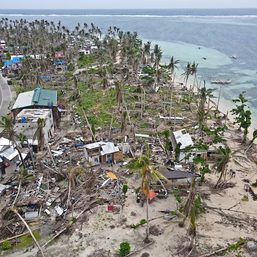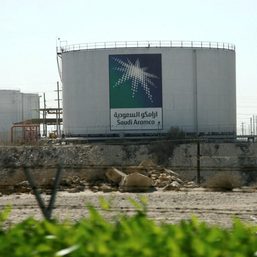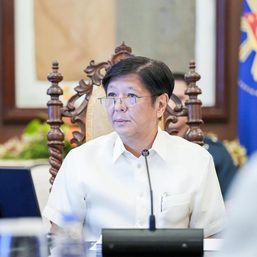SUMMARY
This is AI generated summarization, which may have errors. For context, always refer to the full article.
![[ANALYSIS] What must the Philippines do about climate change?](https://www.rappler.com/tachyon/2021/05/TL-what-Ph-must-do-1280.jpg)
The following is Part 2 of a two-part series. You can read Part 1 here.
The Philippines is one of 191 countries that have deposited their instruments of ratification, acceptance, and approval of, or accession to, the Paris Agreement, which came into force on November 4, 2016. The Paris Agreement represents a monumental breakthrough and paradigm shift in approach, from a mitigation-centric view to one that also emphasizes adaptation and support for universal participation i.e., from both developed and developing countries.
The Paris Agreement sets an ambitious temperature limit as the global pact’s centerpiece. The goal to limit the global average temperature increase “to well below 2°C above pre-industrial levels” and to pursue “efforts to limit the temperature increase to 1.5°C above pre-industrial levels” is a shared global ambition, but implemented to reflect equity and the principle of common but differentiated responsibilities and respective capabilities, in light of different national circumstances. To reach this limit with better chance of success, country parties – the Philippines included – to the Paris Agreement are expected to pursue mitigation and adaptation actions with support, particularly for developing countries.
Commitments under the Paris Agreement
The Paris Agreement frames each country’s commitments to achieve the international pact’s objectives through an instrument called nationally determined contributions (NDC). It calls for country parties to account for their NDCs with transparency, accuracy, completeness, comparability and consistency, environmental integrity, and avoidance of double counting. As the Organization for Economic Cooperation and Development and International Energy Agency Climate Change Expert Group 2018 Paper highlights, accounting of mitigation targets in the NDCs could assist countries in understanding their own and others’ collective progress and achievement vis-à-vis the Paris Agreement’s long-term goals.
Many developing country parties, such as Indonesia, Cambodia, India, and the Philippines, have communicated NDCs/INDCs that are partially or wholly conditional on international support, such as access to a pledged $100 billion a year in climate finance, technology transfers, and capacity building.
While others have included unconditional measures or those undertaken using domestic or nationally mobilized resources in their NDCs, the conditional part can stymie the success of the Paris Agreement. A 2020 published research by W.P. Pauw et al. points out that the existing $100-billion target pledged by developed countries is insufficient to cover the cost of implementing all conditional NDCs. Also, it reveals that the “feasibility [of implementing the NDCs] is challenged because conditions applied…are often not well defined.” Therefore, the prospects for more ambitious NDCs over time is nebulous.
Having this in mind, international climate change scholar Harald Winkler explains that NDCs are essentially starting points with a legal expectation for progression over time to reflect a country’s highest possible ambition. This progression is captured through a mandatory, comprehensive, and collective implementation assessment of the Paris Agreement called the “global stocktake” that has a five-year cycle.
The first global stocktake will be undertaken in 2023. In effect, country parties are expected to reflect a progression of both mitigation and adaptation commitments, including support to developing countries, in their NDCs. This is the broad context and normative expectation that serves as a key consideration in crafting an NDC that is considered Paris Agreement-compliant.
Evolution of the Philippine commitment
Prior to the UN Framework Convention on Climate Change’s (UNFCCC) 21st Conference of the Parties (COP) and joining the Paris Agreement, the Philippines has communicated an intended NDC (INDC) in October 2015. This became essentially the Philippines’ first NDC, as it did not communicate an NDC to replace the INDC when the country submitted its instrument of ratification on March 23, 2017.
The INDC articulates a mitigation target and adaptation measures needing international support for implementation. For mitigation, it seeks a 70% reduction of greenhouse gas (GHG) emissions by 2030 relative to its Business-As-Usual (BAU) scenario of 2000-2030 from energy, transport, forestry, industry, and waste, albeit conditioned on the provision of the means of implementation that the country will receive in the form of technical, capacity, and financial assistance. Also, the INDC utilizes a baseline target that is subject to recalculation based on available data. This means the INDC mitigation contribution is dynamic (as opposed to static) and fully conditional.
The University of Melbourne’s Climate Energy College observes that the 70% below BAU target cannot be quantified, considering that no BAU level has been provided. On the other hand, the Climate Action Tracker has rated the fully conditional Philippine INDC as 2 degrees Celsius-compatible and falls within the “fair share” range. However, the current policies that are in place do not meet the target enunciated in the INDC, including the Paris Agreement’s long-term goal of below 2 to 1.5 degrees Celsius. Therefore, there is an opportunity for the Philippines to address the apparent inadequacy and lack of clarity of the INDC upon its review and update.
On April 15, 2021, the Philippines has communicated an updated NDC. The latest NDC retains both mitigation and adaptation components and articulates a dynamic baseline target similar to the INDC. However, there are substantial changes introduced compared to the INDC. In terms of the Philippine mitigation contribution, the NDC “commits to a projected GHG emissions reduction and avoidance of 75%, of which 2.71% is unconditional and 72.29% is conditional, representing the country’s ambition for GHG mitigation for the period 2020 to 2030 for the sectors of agriculture, wastes, industry, transport, and energy.” This commitment is referenced against a projected BAU cumulative economy-wide emission of 3,340.3 MtCO2e for the same period. Per the NDC, the Philippines endeavors to peak its emissions by 2030.
Analysis of Philippine NDC
At a glance, the NDC commits a higher mitigation contribution compared to the INDC. Also, it commits to an unconditional GHG reduction as differentiated from the wholly conditional INDC. This is a positive note. Surprisingly, however, the NDC drops the forest sector to meet the country’s mitigation commitment. It goes against the grain that one of the actions needed to control the increase in GHG emissions is the conservation and enhancement of GHG sinks and reservoirs, including the important role of forests, as both a carbon sink and a source of GHG emissions. In its Special Report on Climate Change and Land, the Intergovernmental Panel on Climate Change has identified forestry and other land use as a significant net source of GHG emissions.
Also, there are many land and forest-related climate change mitigation options that have co-benefits for climate change adaptation. Accordingly, the Paris Agreement explicitly recognizes the vital role of the forests for achieving its goals by reducing emissions from deforestation and forest degradation in developing countries and the role of conservation, sustainable management of forests, and enhancement of forest carbon stocks in developing countries (REDD-plus). Without the forest sector, however, the Philippine mitigation contribution is weakened by its inexplicable absence in the NDC.
Another glaring omission in the NDC to communicate clearly a baseline target is the planned and implemented policies and actions in the energy sector, as the Philippines’ biggest contributor – about 52% – to GHG emissions. This information is critical in determining the baseline to identify the policies that have or are likely to have significant effect on GHG emissions, including their status, duration, impacts, and how these impacts are estimated. Also, the information should include any policies that have been excluded from the baseline scenario along with appropriate justification. The same set of information will be needed for the agriculture, waste, industry, and transport sectors.
To exemplify, Republic Act (RA) No. 9513 or the Renewable Energy Act of 2008 (REA) and RA No. 11285 or the Energy Efficiency and Conservation Act (EECA) and their accompanying National Renewable Energy Program (NREP) and National Energy Efficiency and Conservation Plan (NEECP) representing the supply and demand-side energy sector policies are omitted in the NDC. Under the Philippine Energy Plan (PEP) 2018-2040, a Clean Energy Scenario (CES) is envisioned where the total GHG emission falls by 26% by 2040, which is driven mainly by the increased share of renewable energy with 37.3% contribution to the power generation mix and a corresponding 54% share to the capacity mix. Energy efficiency and conservation targets and measures also have the potential to reduce energy intensity by 3% across economic sectors. In addition, they are projected to avoid the equivalent of 10% of GHG emissions from current policy projections assuming the full implementation of the targets and measures together with a robust NREP. Without the REA, EECA, NREP, and NCEEP, the mitigation contribution under the NDC is less ambitious.
Fortunately, there is still a window to examine and revisit the existing NDC prior to the global stocktake in 2023 to fill in the gaps, make it as clear and progressive as possible, and attract the international support being sought for implementation. If the NDC is to increase the likelihood of attracting international support, it should quantify and set out clearly with details the baseline targets, policies, methodologies, cost estimates, and investment plans in place, among others, for implementation. Definitely, the Philippines can do more along these lines to concretize the level of ambition articulated in the NDC and align its commitment and contribution with the Paris Agreement. – Rappler.com
Tony La Viña is the Executive Director of Manila Observatory. He also teaches law and is former dean of the Ateneo School of Government.
Dr. Manny Solis is a Senior Research Fellow on climate change of the Manila Observatory and teaches climate change law in San Beda Graduate School of Law. He is currently based in Adelaide, Australia.
Add a comment
How does this make you feel?
![[OPINION] The true test begins in the Philippines’ fight vs climate change](https://www.rappler.com/tachyon/2021/04/IMHO-NDC-pledge-climate-change-April-17-2021-1.jpg?fit=449%2C449)
![[OPINION] The Philippines’ consistently inconsistent climate plans](https://www.rappler.com/tachyon/2021/02/meaningful-climate-ambition-february-5-2021.jpg?fit=449%2C449)
![[OPINION] Grading Marcos admin’s performance on the climate agenda](https://www.rappler.com/tachyon/2024/06/grading-marcos-performance-climate-agenda-june-25-2025.jpg?resize=257%2C257&crop=441px%2C0px%2C1080px%2C1080px)
![[OPINION] No room for ‘business as usual’ in era of climate emergency](https://www.rappler.com/tachyon/2024/06/no-room-business-as-usual-climate-change-june-25-2024.jpg?resize=257%2C257&crop_strategy=attention)
![[OPINION] Climate finance: A call to action for the Philippines](https://www.rappler.com/tachyon/2024/05/tl-climate-finance.jpg?resize=257%2C257&crop=458px%2C0px%2C1080px%2C1080px)






![[WATCH] #TheLeaderIWant: Filipino voters sound off on community issues a year before 2025 elections](https://www.rappler.com/tachyon/2024/05/filipino-voters-sound-off-on-community-issues-1.jpg?resize=257%2C257&crop=276px%2C0px%2C720px%2C720px)
![[OPINION] What’s the right thing to do?](https://www.rappler.com/tachyon/2024/02/imho-whats-the-right-thing-to-do-02242024.jpg?resize=257%2C257&crop=259px%2C0px%2C720px%2C720px)
![[New School] Kagat ng realidad](https://www.rappler.com/tachyon/2024/02/new-school-kagat-ng-realidad-feb-14-2024.jpg?resize=257%2C257&crop=318px%2C0px%2C720px%2C720px)
![[New School] UP DiliMall, dili mall! Hindi nilalako ang edukasyon](https://www.rappler.com/tachyon/2023/11/ns-dilimall.jpg?resize=257%2C257&crop=307px%2C0px%2C720px%2C720px)
![[OPINION] A win for the breadwinner](https://www.rappler.com/tachyon/2023/08/iSpeak-win-breadwinner-August-1-2023.jpeg?resize=257%2C257&crop_strategy=attention)

There are no comments yet. Add your comment to start the conversation.